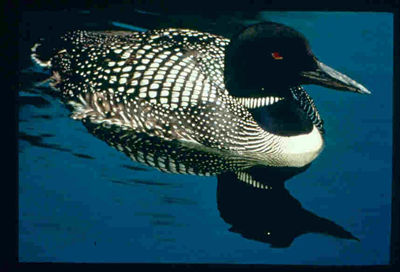- Great Northern Diver
Taxobox
name = Great Northern Diver
status = LC
status_system = iucn3.1
status_ref = [IUCN2006|assessors=BirdLife International |year=2004|id=49674|title=Gavia immer|downloaded=2006-05-09 ]

image_width = 250px
regnum =Animal ia
phylum = Chordata
classis =Aves
ordo =Gaviiformes
familia =Gaviidae
genus = "Gavia "
species = "G. immer"
binomial = "Gavia immer"
binomial_authority = (Brunnich,1764 )
range_
range_map_width = 250px
range_map_caption = Not shown is the eastern part of the wintering range, which encompasses lakes and coastal areas down to Central Europe.
synonyms = "Gavia imber"The Great Northern Diver, known in
North America as the Common Loon ("Gavia immer"), is a large member of theloon , or diver,family .Adults can range from 61-100 cm (24-40 inches) in length with a 122-152 cm (4-5-foot) wingspan, slightly smaller than the similarWhite-billed Diver or "Yellow-billed Loon". The weight can vary from 1.6 to 8 kg (3.6 to 17.6 lbs). On average a Common Loon is about 81 cm (32 inches) long, has a wingspan of 136 cm (54 inches), and weighs about 4.1 kg (9 lbs).The Great Northern Diver breeds in
Canada , parts of the northernUnited States ,Greenland , andAlaska . There is a smallerpopulation (ca. 3000 pairs) inIceland . On isolated occasions they have bred in the far north ofScotland . The female lays 1 to 3 eggs on a hollowed-out mound of dirt and vegetation very close towater . Bothparents build the nest, sit on the egg or eggs, and feed the young.This
species winters onsea coasts or on largelakes over a much wider range in NorthernEurope and theBritish Isles as well as inNorth America .Breeding
adults have a black head, white underparts, and a checkered black-and-white mantle. Non-breeding plumage is brownish, with the chin and foreneck white. The bill is black-blue and held horizontally. The bill colour and angle distinguish this species from the similarWhite-billed Diver .This
species , like all divers, is a specialistfish -eater, catching its prey underwater, diving as deep as 200 feet (60 m). Freshwater diets consist of pike,perch , sunfish,trout , and bass; salt-water diets consist of rock fish,flounder , sea trout, andherring .The bird needs a long distance to gain momentum for take-off, and is ungainly on landing. Its clumsiness on land is due to the legs being positioned at the rear of the body: this is ideal for diving but not well-suited for walking. When the birds land on water, they skim along on their bellies to slow down - rather than on their feet, as these are set too far back.
The loon swims gracefully on the surface, dives as well as any flying bird, and flies competently for hundreds of miles in migration. It flies with its neck outstretched, usually calling a particular tremolo that can be used to identify a flying loon.
These birds have disappeared from some lakes in eastern
North America due to the effects ofacid rain andpollution , as well as lead poisoning from fishing sinkers and mercury contamination from industrial waste. Artificial floating nesting platforms have been provided for loons in somelakes to reduce the impact of changing water levels due todam s and other human activities.The Great Northern Diver is one of the
species to which the "Agreement on the Conservation of African-Eurasian Migratory Waterbirds" (AEWA ) applies.This diver is well-known in
Canada , appearing on the "loonie"coin and the previous series of $20 bill, and is the provincial bird ofOntario . Also, it is the state bird ofMinnesota .The voice and appearance of the Common Loon has made it prominent in several Native American tales. These include a story of a loon which created the world in a
Chippewa story; aMicmac saga describes Kwee-moo, the loon who was a special messenger of Glooscap, the tribal hero; native tribes ofBritish Columbia believed that an excess of calls from thisbird predictedrain , and even brought it; and the tale of the loon’s necklace was handed down in many versions among Pacific Coast peoples. Folk names include big loon, black-billed loon, call-up-a-storm, ember-goose, greenhead, guinea duck, imber diver, ring-necked loon, and walloon."Gavia" is
Latin for "sea smew" (although divers are notSmew ). The specific meaning of "immer" either is:
* related to Swedish "immer" and "emmer", the grey or blackened ashes of a fire, referring to its dark plumage; or
* Latin "immergo", to immerse, and "immersus", submerged.Gallery
References
External links
* [http://blx1.bto.org/birdfacts/results/bob40.htm - BTO BirdFacts- Great Northern Diver]
* [http://www.ns.ec.gc.ca/wildlife/loons/ Loons]
* [http://www.bird-stamps.org/cspecies/800400.htm Stamps: Common Loon]
* [http://ibc.hbw.com/ibc/phtml/especie.phtml?idEspecie=78 Great Northern Diver videos] on the Internet Bird Collection
* [http://digimorph.org/specimens/Gavia_immer/ DigiMorph.org] —CT scans of a Great Northern Diver skull
* [http://animaldiversity.ummz.umich.edu/site/accounts/information/Gavia_immer.html Great Northern Diver] on Animal Diversity Web
* [http://www.mbr-pwrc.usgs.gov/id/framlst/i0070id.html USGS Information - Common Loon]
* [http://www.birds.cornell.edu/AllAboutBirds/BirdGuide/Common_Loon.html Cornell Lab of Ornithology - Common Loon Information]
* [http://sdakotabirds.com/species/common_loon_info.htm South Dakota Birds - Common Loon Information and Photos]
* [http://www.flickr.com/search/groups/?w=42637302@N00&q=great+northern+diver&m=pool Flicker Field Guide Birds of the World] Photographs
Wikimedia Foundation. 2010.
